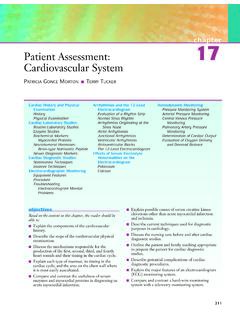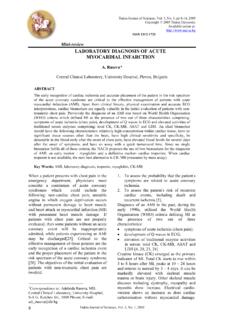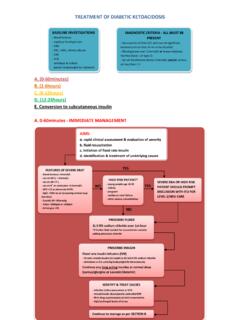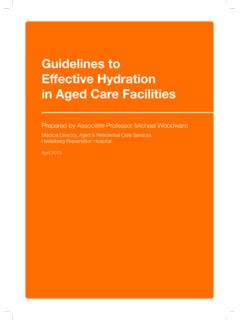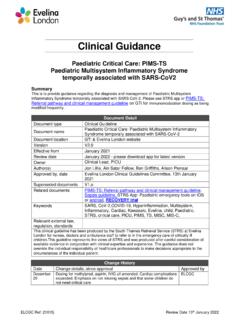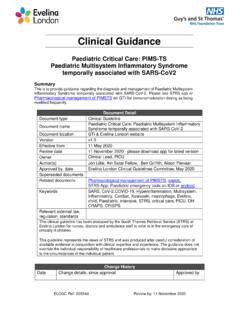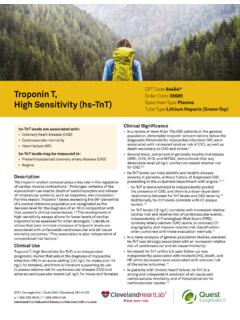Transcription of Biochemical and Biophysical Research Communications
1 Nkx2-5- and Isl1-expressing cardiac progenitors contribute to proepicardiumBin Zhoua,b, Alexander von Gisea,b,c, Qing Maa,b, Jos Rivera-Felicianob, William T Pua,b,*aHarvard Stem Cell Institute and Department of Cardiology, Children s Hospital Boston, 300 Longwood Avenue, Boston, MA 02115, USAbDepartment of Genetics, Harvard Medical School, 77 Avenue Louis Pasteur, Boston, MA 02115, USAcClinic of Neonatology, Charit Campus Mitte, Charit Universit tsmedizin Berlin, Chariteplatz 1, 10117 Berlin, Germanya r t i c l e i n f oArticle history:Received 5 August 2008 Available online xxxxKeywords: cardiac progenitorProepicardiumHeart developmenta b s t r a c tCorrect delineation of the hierarchy of cardiac progenitors is a key step to understanding heart develop-ment, and will pave the way for future use of cardiac progenitors in the treatment of heart Nkx2-5 and Isl1 cardiac progenitors contribute to cardiomyocyte, smooth muscle, and endo-thelial lineages, which constitute the major lineages of the heart.
2 Recently, progenitors located within theproepicardium and epicardium were reported to differentiate into cardiomyocytes, as well as smoothmuscle and endothelial cells. However, the relationship of these proepicardial progenitors to the previ-ously described Nkx2-5 and Isl1 cardiac progenitors is incompletely understood. To address this question,we performed in vivo Cre-loxP-based lineage tracing. Both Nkx2-5- and Isl1-expressing progenitors con-tributed to the proepicardium and expressed Wt1 and Tbx18, markers of proepicardial progenitor , Nkx2-5 knockout resulted in abnormal proepicardial development and decreased expres-sion of Wt1, suggesting a functional role for Nkx2-5 in proepicardium formation. Taken together, theseresults suggest that Nkx2-5 and/or Isl1 cardiac progenitors contribute to proepicardium during heartdevelopment. 2008 Elsevier Inc. All rights approaches hold great promise to improving thetreatment of congenital and acquired heart disease, the leadingcauses of morbidity and mortality in infancy and adulthood,respectively.
3 Realizing this promise will require detailed under-standing of the diverse cardiac lineages and their hierarchies dur-ing heart work indicates that a common multipotent precursordifferentiates into cardiomyocyte, smooth muscle, and endotheliallineages, the major differentiated cell types of the heart[1 3]. Thisprecursor is marked by expression of the transcription factors Isl1and Nkx2-5. Lineage tracing studies indicate that these Isl1- andNkx2-5-expressing precursors contribute to most of the cardio-myocytes and a subset of the smooth muscle and endothelial cellsof the heart[3].Propercardiacmorphogenesisrequi rescontributionofcellsfromthe proepicardium (PE), an outpouching of the septum transversumthat protrudes towards the heart. Proepicardial cells migrate ontothe surface of the heart, forming an epithelial sheet termed the epi-cardium. Epicardial cells subsequently undergo epithelial to mesen-chymal transition, migrate into the myocardium, and differentiateinto smooth muscle and endothelial cells[4 6].
4 In the heart, expres-sion of the transcription factor Wilm s Tumor 1 (Wt1) is confined tothe proepicardium and epicardium[5]. We recently performedgenetic lineage tracing studies based onWt1-driven recombinaseexpression, and found that that progenitors located within the PEand epicardium also differentiate into cardiomyocytes[7]. At thesame time, Cai and colleagues reached the same conclusion usingan independent lineage tracing system based on recombinaseexpression driven byTbx18regulatory elements[8].The lineage relationship between epicardial progenitors and thepreviously described multipotent Nkx2-5+/Isl1+precursor isincompletely understood. While Cai et al. suggested thatTbx18-marked epicardial progenitors represent a novel lineage that iscomplementary to and distinct fromIsl1-marked cells[8], wefound thatWt1-marked epicardial progenitors are descended fromprecursors that express Nkx2-5 and Isl1[7].
5 In this work, we pro-vide further evidence indicating that Wt1+progenitors within thePE are derived from Nkx2-5+/Isl1+precursors. Furthermore, weshow that Nkx2-5 expression is required for normal developmentof the PE, suggesting that Nkx2-5 functionally regulates formationof this and +,Nkx2-5 Cre/+, orIsl1 Cre/+or mice were crossedwithRosa26fsLacZreporters[9 12]for fate map studies. We notethat thisRosa26fsLacZreporter was more robustly recombined thana similar, independently generated reporter[13]. To generateNkx2-5orIsl1knock out embryos,Nkx2-5 Cremice orIsl1 Cremicewere intercrossed. Noon of the day of the plug was defined as0006-291X/$ - see front matter 2008 Elsevier Inc. All rights * Corresponding author Address: Harvard Stem Cell Institute and Department ofCardiology,Children s HospitalBoston,300 LongwoodAvenue,Boston, MA02115,USAE-mail Pu). Biochemical and Biophysical Research Communications xxx (2008) xxx xxxContents lists available atScienceDirectBiochemical and Biophysical Research Communicationsj o u r n a l h o m e p a g e : w w w.
6 E l s IN PRESSP lease cite this article in press as: B. Zhou et al., Nkx2-5- and Isl1-expressing cardiac progenitors contribute to proepicardium, Res. Commun. (2008), All procedures were performed under protocols approved bythe Institutional Animal Care and Use Committee of Children sHospital and immunohistochemistry. Whole-mount X-gal stain-ing forb-galactosidase (b-gal) was performed as previouslydescribed[14]. Immunostaining was performed as described[15].Briefly, the embryos were fixed with 4% paraformaldehyde andcryosectioned at 5 8lm. Cell membranes were permeabilized bywashing with Triton X-100 PBS. The tissues were subse-quently pre-blocked in 5% donkey serum and PBS for h at roomtemperature. The primary antibodies Wt1 (1:100, Santa Cruz),Tbx18 (1:100, Santa Cruz), Nkx2-5 (1:100, Santa Cruz),b-gal(1:5000, MP biomedicals), Isl1 (1:100, Iowa Developmental StudiesHybridoma Bank) were incubated for h at room antibodies were visualized by secondary antibodies(Alex488 or 555, Invitrogen) or by the ABC method (ABC kit, VectorLaboratories).
7 Nuclei were stained with 40,6-diamidino-2-phenyl-indole dihydrochloride (DAPI). The immunostained tissues wereimaged by confocal microscopy (FV1000, Olympus).Results and discussionTo track the descendants of Nkx2-5-expressing progenitors, weused the Cre-loxP lineage tracing approach[12]. Prior to Crerecombination, a floxed stop cassette inRosa26fsLzpreventedb-galexpression, as demonstrated by the absence of X-gal staining inNkx2-5+/+;Rosa26fsLzembryos (Fig. 1A). InNkx2-5 IRES-Cre/+;Rosa26fsLz/+embryos,Nkx2-5reg ulatory elements drove expression of Crerecombinase, which removed the floxed stop cassette. Thisresulted in heritable expression ofb-gal by Nkx2-5+cells and theirdescendants (Fig 1A). At ,Nkx2-5 IRESCre/+;Rosa26fsLzembryosexhibited strong X-gal staining in the developing heart. The proepi-cardium (PE), residing between atrium (A) and left ventricle (LV),was robustly stained.
8 This finding was confirmed in tissue sections,which showed that most PE cells expressed the genetic lineageb-gal (white arrowheads), indicating that cells descended fromNkx2-5+precursors ( Nkx2-5-derived ) contribute to marks a subset of PE cells that differentiate into cardiomyo-cyte, smooth muscle, and endothelial lineages[7,8]. To test if Wt1+PE cells are derived from Nkx2-5-expressing precursors, we co-stained tissue sections ofNkx2-5 IRESCre/+;Rosa26fsLzembryos for Wt1and theb-gal lineage tracer (Fig. 1B). A subset of Nkx2-5-derivedPE cells (b-gal+; red) expressed Wt1 (green,Fig. 1B row 2), indicatingthatWt1+ PE cells were not actively expressing Nkx2-5(green,Fig. 1B row 1), indicating that Nkx2-5 expression occurs transientlyin PE precursors and is not maintained in PE of Cre into the same locus by different strategies canlead to distinct recombination patterns[9,10].
9 To reduce the likeli-hood of a false positive finding due to potentially idiosyncraticFig. cells contribute to proepicardium. (A)Nkx2-5 IRESCre/+;Rosa26fsLzand littermate controlNkx2-5+/+;Rosa26fsLzembryos, stained in wholemount with X-galand then sagitally sectioned. Arrowheads mark the X-gal positive cells in proepicardium. (B) Co-staining of Nkx2-5 (green), Wt1 (green), andb-gal (red) on the same were stained with DAPI (blue). Arrows indicate PE cells that areb-gal and Wt1 positive, and Nkx2-5 negative. Black bar = 500lm. White bar = 100lm. A, atrium; RV,right ventricle; LV, left ventricle; OFT, outflow tract; PE, Zhou et and Biophysical Research Communications xxx (2008) xxx xxxARTICLE IN PRESSP lease cite this article in press as: B. Zhou et al., Nkx2-5- and Isl1-expressing cardiac progenitors contribute to proepicardium, Res. Commun. (2008), of theNkx2-5 IRESC reline, we used a different, independentlygeneratedNkx2-5 Cre knockin line,Nkx2-5 Cre[10], to confirm theabove findings.
10 InNkx2-5 Cre/+;Rosa26fsLz/+embryos,b-gal+cells werealso present within the PE, although the extent of proepicardiallabeling was reduced compared toNkx2-5 IRESCre/+;Rosa26fsLz/+. Theseb-gal+PE cells expressed Wt1 (Supplementary Fig. 1A) as well asTbx18 (Supplementary Fig. 1B), another marker of the PE[8].Collectively, these data provide strong evidence that Nkx2-5+precursors contribute to the PE, suggesting that the PE shares acommon developmental origin with the rest of the heart. The PEgives rise to much of the coronary vasculature[4,16,17]. Consistentwith the finding that Nkx2-5+precursors contribute to PE, our re-cent work indicates that Nkx2-5+progenitors also contribute to asubset of coronary endothelial and smooth muscle cells in embry-Fig. cells contribute to proepicardium. (A) Wholemount X-gal staining ofIsl1 Cre/+;Rosa26fsLzand littermate controlIsl1+/+;Rosa26fsLzembryos.
